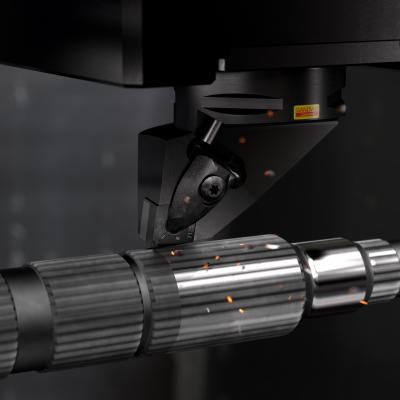
Sandvik Coromant is set to release two new grades for interrupted hard-part turning operations: CB7125 and CB7135. Available in October 2018, the grades will complete the company’s offer for hard-part turning, complementing the existing CB7105 and CB7115 grades.
The latest Sandvik Coromant grades enable the performance of medium-to-heavy interrupted cuts and removal of the hardened layer (depth of cut up to 2 mm) in case- and induction-hardened steel components, typically for the automotive industry. For these applications, CB7125 and CB7135 offer longer and more consistent tool life, good levels of surface finish and consistent dimensional tolerances.
“For everyone working with transmission and other hard-turned components, there is a reason to choose these CBN grades,” explains Torbjörn Ågren, product manager-general turning at Sandvik Coromant. “Not least because adding value in speed capabilities and providing a more secure edge line and consistent tool life means lower cost per component. This is particularly the case when aiming for a one-cut strategy, namely a single cut with larger chip thickness, at high speed.”
CB7125 and CB7135 are optimized for turning steel materials with a hardness of 58 to 62 HRC. Designed for medium intermittent cutting, CB7125 features a new PVD coating that provides improved wear and fracture resistance for extended tool life. This grade, which contains medium CBN content, is ideal for turning shaft splines and shafts with chamfered oil holes or pockets. Further applications include gear facing, the hard-to-soft turning of crown wheels, and the removal of hardened layers.
The CB7135 grade is pitched at the efficient longitudinal turning of gears and shafts with unchamfered keyways or pockets, as well as CV joint components such as the inner/outer race and cage. Featuring a high CBN content, the grade offers high fracture resistance and predictable machining results.
Available for T-Max P, CoroTurn 107 and CoroTurn TR tooling systems, the new grades come in both positive and negative basic shapes, with various edge preparations. Cutting data recommendations for CB7125 include a cutting speed of 100–200 m/min (328–656 ft/min) and feed rate of 0.05–0.45 mm/rev (0.002–0.018 in/rev), while for CB7135 a cutting speed of 80–160 m/min (262–525 ft/min) and feed rate of 0.05–0.4 mm/rev (0.002–0.016 in/rev) should be achievable, depending on the specific application.
Contact Details
Related Glossary Terms
- cubic boron nitride ( CBN)
cubic boron nitride ( CBN)
Crystal manufactured from boron nitride under high pressure and temperature. Used to cut hard-to-machine ferrous and nickel-base materials up to 70 HRC. Second hardest material after diamond. See superabrasive tools.
- cutting speed
cutting speed
Tangential velocity on the surface of the tool or workpiece at the cutting interface. The formula for cutting speed (sfm) is tool diameter 5 0.26 5 spindle speed (rpm). The formula for feed per tooth (fpt) is table feed (ipm)/number of flutes/spindle speed (rpm). The formula for spindle speed (rpm) is cutting speed (sfm) 5 3.82/tool diameter. The formula for table feed (ipm) is feed per tooth (ftp) 5 number of tool flutes 5 spindle speed (rpm).
- feed
feed
Rate of change of position of the tool as a whole, relative to the workpiece while cutting.
- hardness
hardness
Hardness is a measure of the resistance of a material to surface indentation or abrasion. There is no absolute scale for hardness. In order to express hardness quantitatively, each type of test has its own scale, which defines hardness. Indentation hardness obtained through static methods is measured by Brinell, Rockwell, Vickers and Knoop tests. Hardness without indentation is measured by a dynamic method, known as the Scleroscope test.
- physical vapor deposition ( PVD)
physical vapor deposition ( PVD)
Tool-coating process performed at low temperature (500° C), compared to chemical vapor deposition (1,000° C). Employs electric field to generate necessary heat for depositing coating on a tool’s surface. See CVD, chemical vapor deposition.
- turning
turning
Workpiece is held in a chuck, mounted on a face plate or secured between centers and rotated while a cutting tool, normally a single-point tool, is fed into it along its periphery or across its end or face. Takes the form of straight turning (cutting along the periphery of the workpiece); taper turning (creating a taper); step turning (turning different-size diameters on the same work); chamfering (beveling an edge or shoulder); facing (cutting on an end); turning threads (usually external but can be internal); roughing (high-volume metal removal); and finishing (final light cuts). Performed on lathes, turning centers, chucking machines, automatic screw machines and similar machines.

